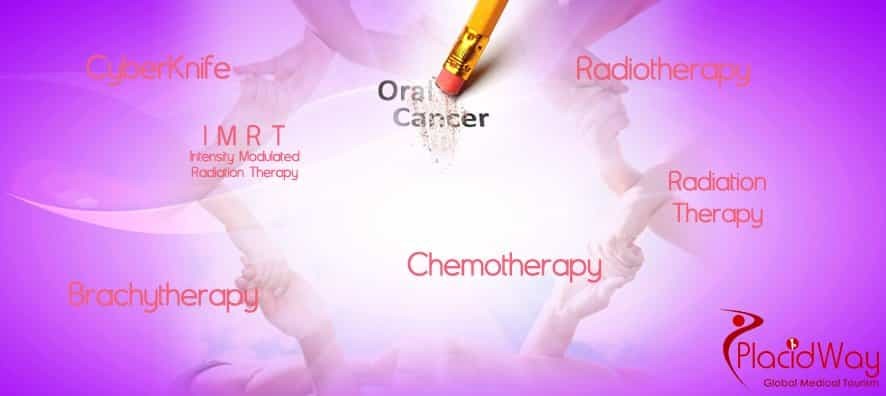

Treatment of oral cancers requires a multidisciplinary approach, thus involving the efforts of oncology surgeons, radiation specialists, chemotherapy oncologists, dentists, nutritionists, rehabilitation and restorative specialists. The actual treatment methods are usually surgery and radiation, with chemotherapy added to lower the chances of metastasis, to sensitize the malignant cells to radiation, or for those patients who have confirmed distant metastases of the disease.
The American Cancer Society study shows that men are twice as likely to develop oral cancer compared to women, specifically men who are over age 50.
Risk factors for the development of oral cancer include:
Fact: 25% of all oral cancers occur in people who do not smoke and who only drink alcohol occasionally.
After a definitive diagnosis has been made and the cancer has been staged, treatment may begin.

The type of treatment for oral cancer which your doctor will recommend depends on the tumor type, location of the cancer and how far it has spread.
Oral Cancer Treatment at Stage 0 (carcinoma in situ)
Oral cancer at this incipient stage can spread if it is not treated. The usual treatment is the removal by surgery of the top layers of tissue along with a small margin of normal tissue (surgical stripping or thin resection). Close follow-up to see if any cancer has come back (recurrence) is important. If this early oral cancer keeps coming back even after resection, it may require radiation therapy.
Nearly all patients at this stage survive for a long time without further intensive treatment. However, continuing to smoke and neglecting the diet leads to increased risk of reccurence.
Oral Cancer Treatment at Stages I & II
Most individuals diagnosed with stage 1 or 2 oral cancer can be successfully treated with either surgery or radiation therapy. Chemotherapy (chemo) may be given with radiation, especially to treat any cancer left after the resection surgery. Both sprocedures are successful in treating stage 1 and 2 oral cancers. The type or types of treatment are chosen by expected side effects, including the effect that the treatment has on the patient's appearance, ability to speak and swallow.
Lip Cancer: Small cancers are often removed with surgery or radiation alone may be the first treatment. Surgery may be needed later if radiation doesn’t completely get rid of the tumor. Larger or deeper cancers often require surgical removal. Special reconstructive surgery is used to correct the defect in the lip. If the tumor is thick, this increases the risk that the cancer may have spread to lymph nodes in the neck, so the surgeon may remove them (lymph node dissection) to be checked for cancer spread.
Oral cavity: For cancers of the floor of the mouth, front of the tongue, inside of the cheek, gums, and hard palate, surgery is the main treatment. Lymph node resection is also used in most cases. If the cancer does not appear to have been completely removed - radiation (often combined with chemo) may be recommended.
Radiation can be used instead of surgery as the main treatment in some patients. This is most often used in patients who can’t have surgery because of medical problems.
Oropharynx: For cancers of the back of the tongue, soft palate, and tonsils, the main treatment is radiation therapy aimed at the cancer and the lymph nodes in the neck. Surgery can be used as the main treatment (instead of radiation) in some cases. This would mean removing lymph nodes in the neck as well (lymph node dissection). If any cancer remains after surgery, radiation (often with chemo) is often used.
Oral Cancer Treatment at Stages III and IVA
Oral cavity cancers (cancers of floor of the mouth, front of the tongue, inside of the cheek, gums, and hard palate): Stages III and IVA include larger cancers, those that have grown into nearby tissues, and those that have spread to nearby lymph nodes in the neck. These cancers are often treated with a combination of surgery and radiation. Surgery is often done first and includes removal of neck lymph nodes (lymph node dissection).
Oropharyngeal cancers (cancers of the back of the tongue, soft palate, and tonsils): Stages III and IVA include larger cancers, those that have grown into nearby tissues, and those that have spread to nearby lymph nodes in the neck. These cancers are often treated with a combination of radiation and chemo (chemoradiation), although radiation and cetuximab may be used in some cases. The effect of combining radiation with both chemo and cetuximab is also being studied. Any cancer that remains after chemoradiation is removed with surgery. If the cancer has spread to neck lymph nodes, they may also need to be removed (a lymph node dissection) after chemoradiation is done.
Another option is to treat first with surgery to remove the cancer and neck lymph nodes. This is often followed by radiation or chemoradiation to lower the chance of the cancer coming back.
Some doctors give chemo as the first treatment, followed by chemoradiation (chemo and radiation given together), and then surgery if needed. Not all doctors agree with this approach, though.
Oral Cancer Treatment at Stage IVB
Cancers that have already spread to other parts of the body are usually treated with chemo, cetuximab, or both. Other treatments such as radiation may also be used to help relieve symptoms from the cancer or to help prevent problems from occurring.
Clinical trials are looking at different ways of combining radiation and chemo with or without cetuximab or other new agents to improve survival and quality of life, and reduce the need for radical or deforming resection of advanced oral cavity and oropharyngeal cancers.
Recurrent Oral Cancer Treatment at (oral cavity/oropharyngeal cancer)
When cancer come backs after treatment, it is called recurrent cancer. Recurrence can be local (in or near the same place it started), regional (in nearby lymph nodes), or distant (spread to bone or organs such as the lungs). Treatment options for recurrent cancers depend on the location and size of the cancer, what treatments have already been used, and on the person’s general health.
If the cancer comes back in the same area and radiation therapy was used as the first treatment, surgery is often the next treatment, if the cancer can be removed completely and the patient is healthy enough for surgery. Usually, external beam radiation therapy cannot be repeated in the same site except in selected cases. However, brachytherapy can often be used to control the cancer if it has come back in the place it started. If surgery was used first, more surgery, radiation therapy, chemo, cetuximab, or a combination of these may be considered.
If the cancer comes back in the lymph nodes in the neck, these are often removed with surgery (lymph node resection). This may be followed by radiation.
If the cancer comes back in a remote area, chemo is the preferred form of treatment to shrink or slow the growth of some cancers for a while and relieve symptoms. Yet these cancers are very difficult to cure. Communicate with your doctor to understand what the goal of treatment is — whether it is to try to cure the cancer or to keep it under control for as long as possible and relieve symptoms. This can help you weigh the pros & cons of each treatment. Because these cancers are hard to treat, clinical trials of newer treatments may be a good option for some.
Note: Patients with cancers treated in their early stages, may have little in the way of post treatment disfigurement. For those whose cancer is caught at a later stage, the results of surgical removal of the disease may require reconstruction of portions of their oral cavity or facial features. There may be adjunctive therapy required to assist in speech, chewing of foods, the problems associated with the lack of salivary function, as well as the fabrication of dental or facial prostheses.
|
|
|
|
|
|
|
Every cancer is different and each patient has a customized To get accurate quotes form the best specialists worldwide |
For more information about Oral Cancer Treatments click the button below.
Cancer Treatment Abroad, Breast Cancer, Lung Cancer